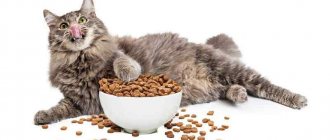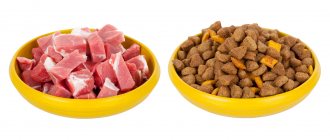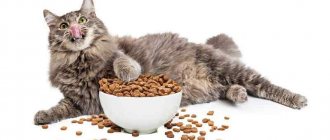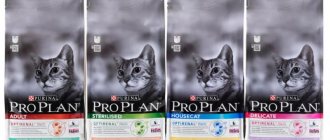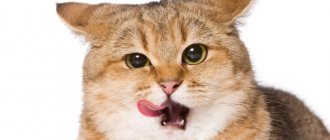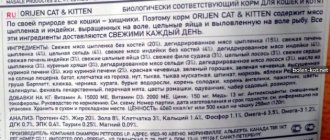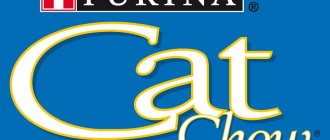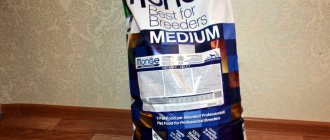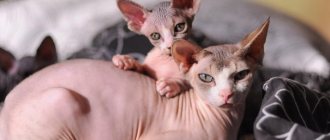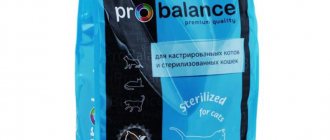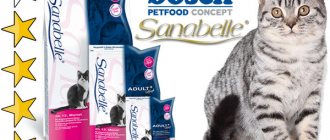Many families have pets. These cute animals lift spirits; caring for them teaches children to work and responsibility, and in some cases can alleviate loneliness. This is why many people love cats, dogs, parrots, canaries, aquarium fish and other “living creatures”. But it’s one thing to love, and another to properly care for animals. For example, cats live in many families, but not everyone takes good care of them. Every little detail is important in this matter, especially proper nutrition. What should cats be fed, what advice do veterinarians give on this matter? Let's figure it out.
Rating of super-premium food for cats
Super-premium nutrition class is a normal diet for animals of any age category. Super premium meals include:
- Proteins - meat or meat ingredients. There is a small amount of protein extracted from peas and potatoes.
- Carbohydrates are often rice or oats. Some super premium foods contain potatoes. Plus the ingredients are less allergenic than corn and wheat, which are used in other types of feed.
- Fats - most often in the form of fish or chicken.
Super premium food uses natural preservatives. If the packaging does not list the preservatives that were used to create the product, it is a fake and does not apply to super-premium.
Rating of super-premium food for cats
Most super-premium foods contain healthy additives and are balanced. Veterinarians recommend using this diet on an ongoing basis. The rating of super-premium food, according to veterinarians, is as follows:
- ALMO NATURE is a company from Italy that produces dry food and canned food. 99% of the food components are whole pieces of fish and meat. The advantages include a large assortment, the absence of unnatural preservatives and GMOs.
- "Fest Choy" - food from a Canadian manufacturer. It produces exclusively dry food, but for all types of pets. There are separate varieties even for picky and capricious eaters. Veterinarians note the nutritional value of the product, as well as the addition of pre- and probiotics to the composition. If animals are fed this food, the smell of excrement will become less pungent.
- NOW NATURAL Holistik is a Canadian super-premium grain-free nutrition developed by professional veterinarians. Fresh boneless meat, as well as vegetables and fruits are the main components of this diet. There are no hormonal components or by-products. Animal fats are also excluded from the products used by this company. The main advantage is the vitamin balance.
- NERO GOLD is a Dutch manufacturer of dry and canned food. A diverse range of products that even includes flavors like turkey and venison. It also contains all the necessary vitamins and microelements. The food does not provoke allergies, therefore it is used for feeding cats sensitive to allergens. But purchasing food in stores is problematic; more often it is ordered via the Internet.
- Arden Grange - food from an English manufacturer for a full life for your pet. Offers both dry and liquid food. The main advantage is that there are no addictive components at all. The composition fully meets the cat's daily needs for useful and nutritious substances.
Be sure to read:
What kind of porridge can be given to cats and at what age?
These are high-end food varieties that are recommended by veterinarians.
Super premium class
This is food for cats and cats with a perfectly balanced composition containing micro- and macroelements, vitamins, animal protein, in the absence of grains, vegetable protein, artificial colors and preservatives. Diets are created to strengthen the immune system, maintain health, coat condition, and prevent diseases of the genitourinary system. The cost is significantly higher than lower class feeds; the composition information provided by the manufacturer exactly corresponds to the actual contents of the feed. Quality is confirmed by certificates.
What food should I feed my cat? The advice of veterinarians is clear: if possible, use super premium diets from the brands Nutra Premium, Arden Grange, Profine Adult Cat and others.
Rating of premium cat food
Rating of premium food for cats
A premium diet is considered to be one in which the content of natural meat products is at least 20% of the total number of components, and there are no additives of non-natural origin. Rating out of 5 premium foods:
- Belcando is a German company that produces dry and wet food. Contains cereals and vegetables. The composition is balanced in accordance with the cat's daily needs for nutrients and beneficial elements.
- Bozita is a diet from a Swedish manufacturer, exclusively for healthy cats. The line does not include medical nutrition. The main components are meat and fish. Increases immunity. The disadvantages include the lack of indication of the preservatives used.
- Flatazor is a French line of food without GMOs and additional additives. The composition contains components containing fatty acids, vitamins (including group B) and minerals, brewer's yeast and natural preservatives. No soy or corn.
- Iams - American dry and wet cat food. Main components: fish, folic acid and taurine. There are no harmful additives. The downside is the corn flour content.
- Natural Choice is a Canadian food that contains essential nutrients for cats. The animal protein content is one third, and it is all a natural product. There are also hypoallergenic food options.
The main advantages of premium food are reasonable cost and distribution in pet stores. There is no need to order food online. Feeds of a higher level will be expensive for owners, and it is much more difficult to find them in stores.
Feed recommendations
You can feed your cat the following healthy foods (the rating is based on veterinarian recommendations and reviews):
- -: high content (42%) of animal protein Orijen
- – high content (30%) of NOW Natural fish oil
- - maximum concentration of fats in poultry and fish - Akana
- — combining plant and animal proteins Royal Canin
- — Hill's contains beef, rabbit, poultry
- — for dietary nutrition based on low-fat fish and poultry Bosch SANABELLE
- .- high-protein (up to 30%) food from rabbit, poultry and fish 1-st Choice.
- - meat and dried egg (75-76%), vegetable ingredients in Arden Grange.
Not only the type of feed is important, but also its correct use. This will affect the health, activity of the pet, and its appearance; the coat will delight itself with health and shine. The decision to purchase is made by the owner of the animal, understanding not the savings (Whiskas and the like contain only 4% of the nutritious meat component), but the saturation of the portion will help offset the costs.
Rating of holistic food for cats
Rating of holistic food for cats
Holistic food is a product consisting only of fish or meat (it does not contain grains). Thus, manufacturers reduce the cost of production, and as a result, the food turns out to be budget-friendly. Rating of optimal feeds in this class:
- Golden Eagle is an American product created by experienced veterinarians. There are dietary meals and feeds for different age categories.
- Innova Evo is a diet used from an early age. There is a line for kittens at 1.5 months. Contains milk, probiotics and fish oil.
- GO! – popular food in Russia from a Canadian manufacturer. The composition contains minerals and vitamins, and only natural preservatives are used. The disadvantages include the high price compared to analogues.
- Wellness Core - food from 5 types of meat, as well as potatoes and tomatoes. Tomatoes are a source of essential antioxidants.
- Acana is a Canadian manufacturer of high quality cat and dog food. The main component is fresh meat. The manufacturer tried to create food that is as close to natural nutrition as possible. According to a study by Roskachestvo, the food could successfully receive the Russian quality mark (if it were produced in Russia). There is a minus - a large amount of fat.
Veterinarians claim that holistic foods are not fully balanced due to the lack of grains. But at the same time, the food belongs to professional types of food, since it was developed by veterinary specialists taking into account the balance of price and quality.
Be sure to read:
Proplan or Royal Canin: which food is better for cats, comparison, how to choose the best
Criterias of choice
Veterinarians in reviews of good cat food advise purchasing food whose packaging contains the following information:
- The abbreviation of the American Food Control Association is AAFCO.
- Indication of the source of protein in the composition and its percentage - at least 25%.
- It is advisable that the food contains at least two protein sources to provide the required amount of amino acids.
- Recommended amount of feed per day. The smaller the volume indicated, the higher the digestibility and nutritional value of the selected product.
- The presence of fatty acids, taurine, arachidonic acid, as well as rosemary, vitamins A, C, E, used as natural preservatives.
- Production time.
A specialized diet is required for kittens, nursing and pregnant cats, and pets with certain diseases. Medicinal food is purchased only after consultation with veterinarians.
How to choose a diet and what food to feed your cat? Veterinarians in the councils do not recommend choosing food whose label contains the following information:
- Mentions of the presence of offal and bone meal - these ingredients are undesirable for cats.
- Large amount of feed, which indicates poor digestibility of the product.
- Contains propyl gallate, ethoxyquin, BHT, BHA - substances that are chemical preservatives, as well as dyes, corn, flavors, wheat.
Economy class feed rating
Rating of economy class food
Economy class is the most popular among the population, since almost everyone can afford such food and is sold in many stores. But veterinarians do not advise getting carried away with feeding cats such food, since it is not healthy. The nutrition is not completely balanced, and some components of such feeds are only partially absorbed. List of economy-class cat foods based on the opinions of independent experts:
- Darling is a predominantly cereal food. Meat in the diet - 4%. The composition also contains preservatives and dyes. May cause allergic reactions and digestive problems.
- Diamond - does not contain dyes or preservatives. The only preservative is vitamin E. The percentage of meat content is 6%. This is normal for this budget category of diets.
- Dr. Alders - German food contains meat and vegetable components with a minimum of processing. But there is little meat in it, the food is mainly plant-based, and therefore inferior.
- Dr. Clauders is another German food, but completely without meat. It is replaced with liver and some other offal. The benefits include ample amounts of chicken fat.
- Lara is a classic food of this class with a low percentage of meat and a high content of grain and vegetable components. There is a range for all age groups and for cats after sterilization.
Economy class food cannot fully provide a cat’s body with vitamins and minerals, and therefore such food should not be used as the sole and main source of food. It's more of an inexpensive supplement.
Feed classification
The division of feed produced in factories looks like this:
- - wet or pouch (jelly, pate, canned food), produced in sealed packaging, often with inclusions of meat or fish pieces drenched in sauce. Canned food is cheaper, but sometimes low quality products are used.
- - food in granules (dry). The most convenient, especially for owners whose pets are home alone all day. The dose of food is regulated by the animal itself - it determines it independently. Practicality is expressed in the fact that it does not dry out, is stored for a long time, and the food does not spoil after falling asleep and being in the feeding container. But the fact that it is impossible to verify the quality of the original ingredients is a negative side, forcing the buyer to purchase products only from recommended brands.
There are specialized foods for treating cats, and there are treats without a calorie load - treats.
The above types are in turn divided into classes:
- Budget-friendly, but meat-free (or with very minimal content) in the economy category. A lot of money for advertising, a poor lineup and widespread sales (Kitekat, Whiskas, Oscar, Felix, Friskas).
- With natural and artificial additives - Premium class. The most popular among breeders and manufacturers are Royal Canin, Eukanoba, Bozita, Nutro Choice.
- Even more expensive, but without dyes and with rich meat content - super premium, its calorie content allows you to reduce the serving size. The ingredients have passed all necessary quality controls. Super premium brands - Arden Grange, Brit Care, Nutram, Farmina N&D, Acana.
- The most expensive, containing up to 90% meat component, without preservatives and artificial additives, is the holistic class. Food in this category does not need advertising; many cat owners have probably heard of brands such as: Alleva, Holistic Blend, Organics, Canidae, Brit Care, Power of Nature, Felidae, Applaws, Grandorf, GO!, NOW!, Barking Heads, Meowing Heads, Almo Nature, Piccolo, Hoistik Summit, Pronature Holistic, Wolfsblut, Savarra, Organics. The name “holistic” declares the principle “the value of a separate part is lower than the value of the whole.”
Listed below are ingredients that are undesirable and have no benefit when included in food.
After studying the list, you can choose an inexpensive and harmless diet for cats.
- - bird and animal by-products (beaks, claws, feathers), also known as "animal mixture" - strong allergens
- - the liver, according to experts, potentially dangerous, toxic substances accumulate in the body.
- - the high glycemic index in potatoes potentially threatens the development of diabetes.
- - yeast,
- -sugars and their derivatives;
- — soy protein concentrate is a strong allergen related to genetically modified organisms;
- - wheat or flour, gluten, corn and processed products made from it - cause allergies;
- — synthetic additives with the letter E;
- -salt, even in the smallest amount;
There is no general consensus on the use of natural or industrial food, but the balance of ready-made food gives it some advantage. Experts believe that it is not worth combining both types.
Prices for food of different classes for cats
Prices for different classes of cat food
Prices for food vary depending on the type of diet. But there may be price fluctuations within different classes:
- Super premium food. The most expensive. Their price ranges from 1000 rubles per pack of dry food 1.5-2 kg. There are also expensive options starting at 2,000 rubles per kg.
- Premium dry food costs from 700-800 rubles per 2 kg.
- Holistic will cost the owner approximately 600 rubles per 1 kg.
- Economy class meals are affordable and start from 200 rubles per 1 kg.
Wet diets vary in cost:
- Super premium - 80 rubles per 50 grams.
- Premium - 50 rubles per 50 grams.
- Holistic - 40 rubles per 50 grams.
- Economy - 25-30 rubles per 50 grams.
Cat food is one of the products whose price directly depends on the quality. The more natural meat there is and the more balanced the food, the more expensive it will be.
Requirements for different types of nutrients
In cats that live in the house, energy expenditure is minimal (hyperactive individuals are rare). They lie or sleep most of the day; if there are too many nutrients, their weight increases.
The volume of consumption depends on many factors:
- mass, fatness;
- physiological state (before mating, during pregnancy, feeding kittens);
- age, breed characteristics;
- health conditions;
- time of year (mainly temperature, which determines heat transfer).
Expert opinion
Dusheba Vera Ivanovna
In 2010, she graduated from the Moscow State Academy of Veterinary Medicine named after K.I. Scriabin with honors, specializing in veterinary medicine. I regularly attend veterinary conferences, congresses, and webinars.
Cats are not characterized by metabolic flexibility; they are not able to adapt if the diet is incorrectly selected. Young individuals per kilogram of weight should receive 200-250 kJ, 30-50% more during pregnancy, 3-4 times more during feeding of the offspring. Neutered animals require a low-calorie diet.
Squirrels
Compared to dogs, cats need 3 times more protein. What is important is the completeness and content of essential amino acids (found only in meat): taurine, sulfur-containing compounds, methionine, cystine. If there are not enough of them in the food, cats become seriously ill. An excess is also undesirable. With any deviation, metabolic processes are disrupted, pathogenic bacteria develop, and immunity decreases.
Fats
Cats do not need vegetable fats; they do not replenish their supply of vitamins and fatty acids. The content of animal fats in the food of kittens is 15%, for adults 20%. With less volume, kittens grow poorly, adult animals suffer from skin diseases and vitamin deficiency.
Carbohydrates
Carbohydrates are divided into difficult and easily digestible (starch). The first group includes fiber; it serves as a preventative against diarrhea and constipation. The main source is vegetables. With excess starch, diabetes can develop.
Vitamins, minerals
For cat food, the balance of mineral and vitamin components is very important. The volume increases for young individuals, during pregnancy and feeding. If there is an insufficient amount of these substances, some disease immediately develops. Vitamin A, found in animal livers, is especially important.
What is the best cat food?
Each owner chooses the appropriate food for their pet independently. But you should definitely consult a veterinarian. If the cat is prone to allergies, then the food should be hypoallergenic (anti-allergenic). If you have certain diseases, then you need to buy products from medicinal lines.
Be sure to read:
What is cat food made from: how is it made wet and dry, can you make it yourself?
What is the best cat food?
Most manufacturers have separate foods for sterilized cats, neutered cats, and pets with oral diseases.
Among the budget options you can also choose food for your pet. Therefore, the best food is the one that is suitable for a particular pet and that is recommended by a veterinarian.
What foods should be excluded from a cat's diet?
Certain foods are prohibited for cats:
- Milk. It is permissible to give it only to kittens up to 3 months; The body of an adult cat cannot digest it.
- Fatty foods. They provoke pancreatitis.
- Raw meat and fish. They may contain parasites, and frequent consumption of fish leads to metabolic disorders.
- Bones. They get stuck in the cat’s mouth and throat, damaging internal organs.
- Vegetables high in carbohydrates. Starch and similar substances can trigger diabetes.
- White cabbage. Leads to bloating.
- Mushrooms and eggplants. Causes severe poisoning and is dangerous for cats.
- Salt. In large quantities, it disrupts electrolyte balance and metabolism, and can lead to the formation of kidney stones.
- Spices. Provoke disturbances in the gastrointestinal tract.
- Chocolate. Strong allergen. Toxic to most pets.
- Garlic and onion. They contain disulfide, which destroys red blood cells and leads to blood diseases.
Natural food is a diet that requires from the cat owner not only financial and time investments, but also emotional stability. Cats are manipulators of the animal world, knowing how to influence their owner’s decisions. In addition, many owners feed their pets according to the principle “the animal knows best what is good for it.” This approach often results in serious health problems.
Ready-made food may not satisfy the animal's taste preferences. In such cases, begging for tasty treats from the table begins, which must be prevented: store-bought diets are as balanced as possible and do not require additives. Vitamin and mineral complexes should be included in the diet only after consultation with a veterinarian - he will help you choose the appropriate medications based on the cat’s tests.
Developing the right habits for feeding a cat takes years. You can pamper your furry pet with a variety of natural products prepared at home. If you wish, you can consult a veterinary nutritionist and get acquainted with specialized recipes developed for cats.
Special food or natural product?
Human food is not suitable for daily feeding for cats. This primarily applies to processed meat. There are too many preservatives and dyes. Therefore, instead of sausage, it is better to offer your cat high-quality dry or wet food.
If we talk about a balanced diet, it is very difficult to follow it yourself. In order for the cat to receive all the necessary substances every day, it must eat vegetables, grain components, meat, and fish every day. Therefore, premium professional food will be the best option. It is advisable to consult a veterinarian before purchasing.
From prescription diets to a healthy diet
More patients were taking prescription medications or eating prescription food. This was supposed to help cope with the diseases that Andrea saw daily in her practice:
- persistent problems with the bladder and urinary system,
- obesity,
- diabetes,
- chronic nausea and/or diarrhea,
- chronic constipation,
- asthma,
- skin and ear problems, to name a few.
To help sick cats, Andrea prescribed many medications, but encountered side effects and complications from taking the drugs. In other cases, the medications simply stopped working after a while. Prescription food was no more beneficial: cats often refused it. Those animals that ate it did not experience any changes for the better.
One day, one of the veterinarian’s clients told her that she had switched her cat Max to raw food. After a few weeks, the woman noticed that the cat’s chronic skin and ear problems had disappeared. Before this, poor Max had to take cortisone-based medications and eat prescription food (prescribed by Andrea) for years, but there was no progress. After this story, Andrea decided to study in detail the issue of feeding cats.
Andrea studied the literature and spoke with veterinarians and owners who fed raw food to their pets. After this, she decided to switch her cat Bug to a raw diet. When Bug was picked up, he was six months old, emaciated, and his life was in serious danger. After Bug switched to a natural diet, he blossomed right before his owner’s eyes:
- gained muscle mass, but did not get fat,
- got beautiful fur,
- many of his chronic illnesses went away on their own, without taking medications.
Andrea is sure that the reason for Bug’s healing was the switch to raw food.
Can neutered cats eat fish?
Neutered cats need a special diet as they are prone to developing urolithiasis and obesity. The first rule for those who keep a neutered cat: the animal should not be overfed. When your pet eats fish, the amount of salts in the body increases and the risk of sand deposits increases sharply. This leads to the formation of stones. Experts have come to the general opinion that fish should be limited. Professional food for neutered cats also does not contain fish.
Recipes and menu planning for cats
In the wild, cats eat their prey completely. Along with the meat of rodents and birds, internal organs, bones, the contents of the victim’s stomach, blood, and part of the wool and feathers enter the stomach. Cute domestic fluffies are also predators, so when creating the right menu, you should strive to bring it as close as possible to the “wild” one. The main condition is the predominance of proteins and fats of animal origin, all other components are much smaller in volume.
You need to thoroughly study what can be included in a cat’s menu in order to get a complete, balanced diet, which foods can be fed to pets raw, and which only after heat treatment.
Here is one of the options for an approximate natural menu for the week.
- Monday. In the morning – minced beef, grated vegetables; in the evening – kefir (or fermented baked milk), egg.
- Tuesday. In the morning – chicken meat (pieces), cereal porridge; in the evening – offal, ½ teaspoon of vegetable oil, chopped lettuce.
- Wednesday. In the morning - beef heart, grated zucchini; in the evening - cottage cheese.
- Thursday. In the morning – boiled chicken pieces with porridge; in the evening – minced beef with a few drops of olive oil, an egg.
- Friday. In the morning – boiled beef with grated vegetables; in the evening - fermented milk products.
- Saturday. In the morning – boiled beef with porridge on water; in the evening - offal, greens.
- Sunday. In the morning – boiled turkey, grated vegetables; in the evening - boiled sea fish without bones, chopped sprouts of sprouted cereals.
Good meat is not cheap, but you can provide your home predator with a complete diet without spending much. Useful, proven recipes for cat preparations will help with this.
- Meat mix. Any non-prohibited meat products will do. All components (chicken breasts, hearts, stomachs) are washed with cold water, cleared of visible fat and films, cut into small pieces, mixed, portioned into cups and placed in the freezer. Thaw at room temperature before use.
- Chicken heads and necks. Many are horrified at the thought that their pet will chew this unsightly food, but in vain. These are the foods that your cat will happily eat without harm to health and with great benefit if they are prepared correctly. After washing, you need to remove the skin from the heads and trim the beaks, and also remove the skin and fat from the neck parts. The heads should be cut in half lengthwise, the necks should be cut into pieces of 1.5-2 cm. It’s good to tap the bones a little with a hammer. You can form portions of heads and necks approximately 50/50, you can put them separately in plastic boxes and freeze.
- Cutlets. The main part of the composition is various meat products (rabbit fillet, beef heart, turkey or chicken by-products). Add very little cereals and vegetables so that the cat does not feel the “fraud” and refuse such food. Pass the ingredients through a meat grinder with a large wire rack, stir well, form into cutlets and refrigerate.
Nutrition for domestic cats is the most important element in keeping animals. When feeding them homemade food prepared with your own hands, you need to carefully monitor the pet’s condition in order to promptly replace food in the diet that for some reason is not suitable for a particular cat. If a four-legged “family member” permanently lives in the house, you must treat him with full responsibility, feed and care for him properly.
For information on proper nutrition for cats, watch the following video.
Preventing diseases with proper nutrition
The main diseases of cats occur due to problems with nutrition and low activity. Therefore, to prevent diseases, you need to properly balance your diet. There are lines of food on sale from various manufacturers that prevent the development of urolithiasis, kidney failure, excess weight, and vitamin deficiency. You won’t be able to formulate a diet for your pet this way yourself.
To prevent disease, the diet must contain all vital vitamins, amino acids and microelements.
Natural nutrition
A cat’s diet from natural products requires the owner’s involvement in the process, accurate calculations, knowledge in the field of veterinary medicine, in particular animal nutrition, and, of course, large financial investments. Such food is often more expensive than premium segment feed. A mandatory item is the presence of vitamin and mineral supplements in the diet, the choice of which is made only after consultation with a veterinarian.
How to give water to a cat
Water plays an important role in the life of cats. The amount of fluid absorbed depends on the type of food. If a pet is on dry food, then per day it needs three times more water than the amount of food eaten. That is, if a cat has eaten 50 grams of dry food, then ideally it should drink about 150 ml of water. When feeding your pets natural food or eating ready-made wet canned food, the need for liquid is reduced.
The water must be clean and filtered. It is not advisable to use boiled or running water.
Any owner of a furry friend wonders how to feed a cat correctly, what is best to use so that it receives only useful substances. In order not to worry about the health of your animal and to avoid problems with it in the future, it is better to use the tips and recommendations about feeding given in this article.
What else to see:
How to create a natural diet
Since the cat is a representative of predatory animals, meat products should predominate in its food. The most successful option is poultry meat. It is also necessary to include meat by-products in your pet’s diet: liver, tendons, necks and heads.
The meat must be boiled and cut into small pieces. Some pets prefer raw meat. Before giving it, it must be cut and then scalded with boiling water. For animals that have dental problems, the meat can be ground into minced meat.
Feeding cats natural food should also meet the animal's fiber needs. Your pet will receive them from plant foods, which have a positive effect on the functioning of the gastrointestinal tract. Usually cats, due to their predatory nature, do not want to eat vegetables, so we advise you to boil them, puree them and mix them with meat to make something like a meat salad.
What vegetables can you feed your pets? We recommend paying attention to zucchini, beets, carrots and cauliflower. Many cats really like canned corn.
Fish should be included in the animal's diet in small quantities. But it should be exclusively marine: flounder, cod, salmon, trout, shrimp, etc.
It is very important that the fish is boiled and has practically no bones.
This is interesting! There is a risk of developing urolithiasis in cats that eat fish products due to the phosphorus and magnesium they contain. But for healthy animals, eating fish products 1-2 times a week is not only not dangerous, but also very desirable.
Feeding your cat natural food should also include fermented milk products:
- cottage cheese;
- kefir;
- cream;
- unsalted cheese;
- sour cream, etc.
You can give your animal eggs once a week, preferably quail eggs - raw or soft-boiled. More frequent feeding can lead to kidney problems.
A cat's menu should include small quantities of cereals: rice, oatmeal, semolina. Cats don't really like them, but they are needed for better functioning of the gastrointestinal tract. Cereals are boiled in water and mixed with fish or meat. It is useful to give milk porridge to lactating or pregnant animals, as well as kittens.
Pet stores sell green grass especially for cats, which you can grow yourself at home. Cats love to eat it, and you need to give them sprouted greens every day.
Features of feeding kittens
In most cases, kittens come to their owners at the age of 2-3 months and are already fully accustomed to feeding on their own. For normal growth and full development, they need to be provided with:
- Feeding at least five times a day and even more, since absolutely all cats require frequent food intake, but in small portions.
- A sufficient amount of protein and vitamins, which is only possible by adding boiled chicken, beef, fresh and boiled vegetables, and grains to the diet. Only a balanced diet will ensure the normal formation of bones and immunity.
- Fermented milk products several times a week. You can give cottage cheese, kefir, yogurt, fermented baked milk, as they contain an increased amount of calcium necessary for the formation of strong bones.
Food should be slightly heated, since cold foods inhibit all digestive processes, and excessively hot foods provoke thermal damage to the delicate mucous membrane.
But how to properly feed very small, newborn cats? After all, situations with the throwing of such crumbs or the disappearance of the mother occur quite often. To feed the baby you will need a special veterinary formula or a regular baby formula intended for infants. It should be given slightly warmed every two hours using special bottles, pipettes or syringes without a needle. During feeding, it is important to ensure that the kitten does not swallow air, as this will cause abdominal pain. Gradually, the intervals between meals increase, and the temperature of the mixture drops to room temperature.
